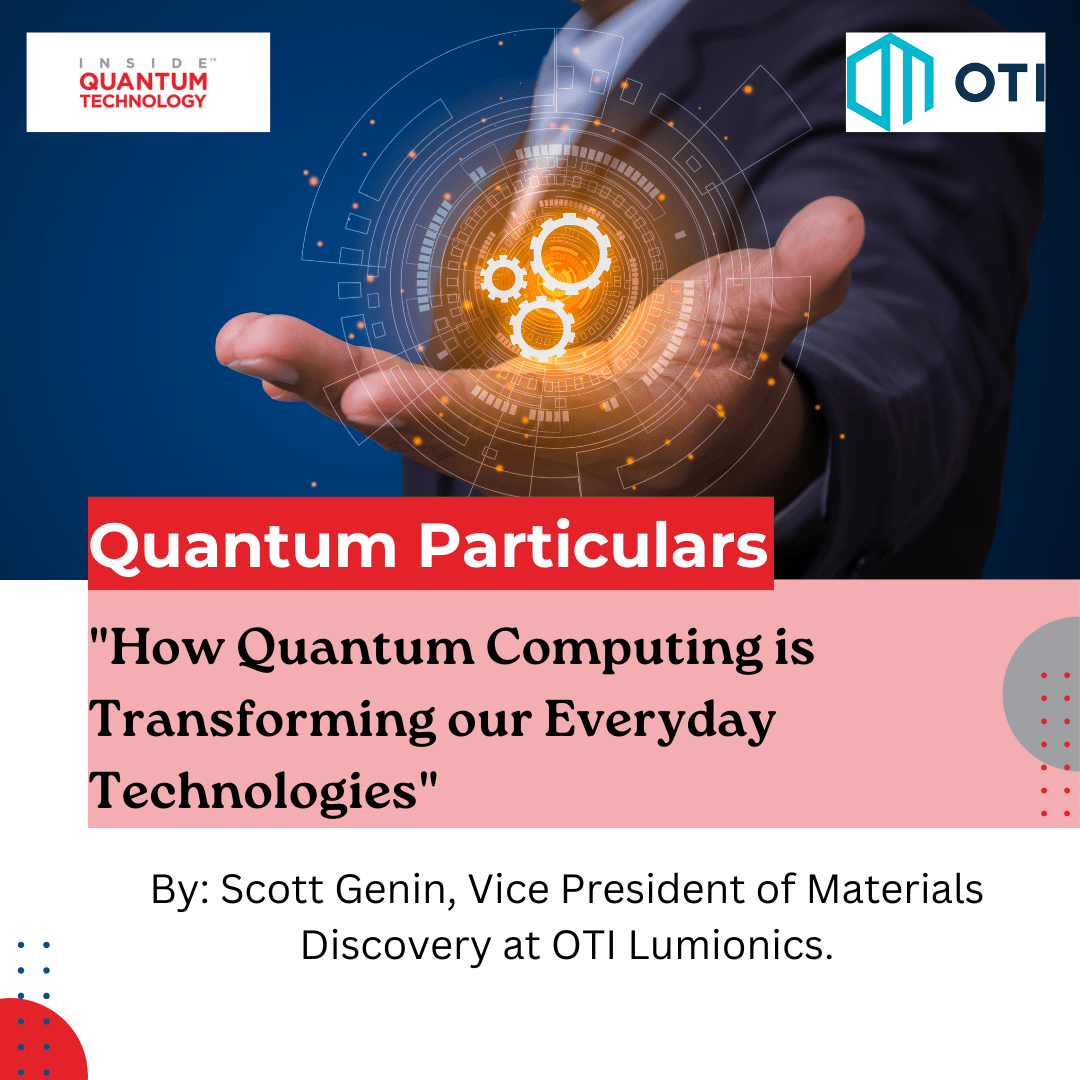
By Kenna Hughes-Castleberry posted 21 Mar 2024
“Quantum Particulars” is an editorial guest column featuring exclusive insights and interviews with quantum researchers, developers, and experts looking at key challenges and processes in this field. This article, discussing everyday technologies and quantum computing was written by Scott Genin, Vice President of Materials Discovery at OTI Lumionics.
Classical computing has been the backbone of innovation, fueling advancements in various consumer and industrial sectors. However, the emergence of quantum computing is set to redefine the landscape of digital progress, paving the way for next-generation technologies.
OTI Lumionics is one company leveraging quantum computing to spearhead the development of groundbreaking materials for the display industry. Despite the pervasive impact of these technological breakthroughs on our daily lives, the broader public remains largely unaware of the pivotal role quantum computing plays in shaping the future of technology.
How Quantum Computing Can Advance Everyday Technologies
Quantum computing offers unparalleled capabilities in material simulations, boasting accuracy that significantly accelerates the research and development process. This translates into substantial time and cost savings, expediting the product development timeline. With the ability to solve complex problems and perform calculations at unprecedented speeds, quantum computing enables scientists to push the boundaries of innovation beyond the constraints of classical computing.
Many consumers upgrade to the newest smartphone the moment it comes out or desire the nicest, newest luxury car because of the upgraded technology features. Blinded by the awe of the latest and greatest upgrades, consumers are unaware of how quantum computing is helping manufacturers and scientists make these improvements to the world’s most heavily relied-on technologies.
A Dive into LED Displays
One of the most impactful ways quantum computing is used for consumer technology is by developing OLED displays. Worldwide, there are approximately 6.94 billion smartphones. To put that into perspective, that figure accounts for around 85% of the 8 billion global population, and that’s not considering OLED laptops, tablets, monitors, and TVs!
Through quantum computing, scientists discover advanced materials that create OLED or micro-OLED displays for smartphones, improving it over time for consumers. Experts can utilize quantum simulations and machine learning to look at different material combinations and produce faster material simulations, and more accurate predictions of how the material will perform and do it at a lower cost in-house. It is beneficial for manufacturers to develop these intricate and evolving displays, making it possible to keep up with industry standards and the constant need for technological improvements.
Because of quantum computing, devices are upgrading incredibly, with transparent screens, under-display cameras, biometrics and upgraded automotive infotainment systems.
Transparent OLEDs
Transparent displays create a magical experience, capturing the user’s imagination and appearing as if the image is floating in thin air. Transparent OLED displays allow for novel application sets in a variety of industries, like automotive, mass transportation, retail display, entertainment, and teleconferencing. They are emerging and showcasing a unique application space for OLED technology and can soon be found inside automobiles, shopping malls, museums, amusement parks, and more.
Under-Display Cameras
Under-display cameras are the staple example of how everyday technologies can be impacted by quantum computing developments. Materials discovered through quantum simulations allow manufacturers to remove the notch on a phone or laptop to create a more organic video-chatting conversation. Instead of having to look at the dynamic island on the top of the phone, implementing under-display cameras will improve the interactions consumers have on their devices by making eye contact with each other through the under-display cameras. These cameras are also becoming popularized as a security tactic for improved device facial recognition.
Biometric Technologies
With upgraded under-display cameras, this calls for improvement in biometrics. Some consumers state that current facial recognition doesn’t work as well under low-light conditions. Through quantum simulations, experts can provide higher levels of transparency and clarity, granting quicker and clearer access with face ID. Due to quantum findings, experts found that pixels can open microscopic holes under the display, leading to better transparency and improved consumer electronics.
Automotive Sensor Integrated Display
Quantum computing is also being heavily utilized to improve display systems in vehicles. Through simulations, developers have found a way to use the under-display cameras as an eye-tracking tool that is being implemented as a safety feature to alert drivers when they’ve become distracted and need to revert their eyes to the road. Additionally, improved OLED displays are elevating the experience drivers have with state-of-the-art, transparent and touchscreen infotainment panels as well as customizable tail and headlight displays.
Because of quantum computing, devices are upgrading in incredible ways and bringing the next greatest advancements to market. Whether it is transparent screens, upgraded automotive infotainment systems, immersive VR experiences or under-display cameras, quantum computing is the reason technologies improve everyday life.
Scott Genin is the Vice President of Materials Discovery at OTI Lumionics. He has a Ph.D. in Chemical Engineering from the University of Toronto
- SEO Powered Content & PR Distribution. Get Amplified Today.
- PlatoData.Network Vertical Generative Ai. Empower Yourself. Access Here.
- PlatoAiStream. Web3 Intelligence. Knowledge Amplified. Access Here.
- PlatoESG. Carbon, CleanTech, Energy, Environment, Solar, Waste Management. Access Here.
- PlatoHealth. Biotech and Clinical Trials Intelligence. Access Here.
- Source: https://www.insidequantumtechnology.com/news-archive/quantum-particulars-guest-column-how-quantum-computing-is-transforming-our-everyday-technologies/
- :has
- :is
- :not
- $UP
- 2024
- 7
- 8
- a
- ability
- About
- accelerates
- access
- Accounts
- accuracy
- accurate
- Additionally
- advance
- advanced
- Advanced materials
- advancements
- affect
- AIR
- Alert
- allow
- also
- amusement
- an
- and
- appearing
- Application
- approximately
- ARE
- around
- article
- AS
- At
- automotive
- Backbone
- BE
- because
- become
- becoming
- been
- being
- beneficial
- Better
- Beyond
- Billion
- biometrics
- boasting
- boundaries
- breakthroughs
- Bringing
- broader
- by
- calculations
- Calls
- cameras
- CAN
- capabilities
- Capturing
- car
- categories
- challenges
- chemical
- clarity
- clearer
- Column
- combinations
- comes
- company
- complex
- computing
- conditions
- considering
- constant
- constraints
- consumer
- consumer technology
- Consumers
- contact
- Conversation
- Cost
- cost savings
- create
- Current
- customizable
- daily
- day
- desire
- Despite
- develop
- developers
- developing
- Development
- developments
- device
- Devices
- different
- digital
- discover
- discovered
- discovery
- discusses
- discussing
- Display
- displays
- dive
- do
- Doesn’t
- drivers
- due
- dynamic
- each
- Editorial
- Electronics
- elevating
- emergence
- emerging
- enables
- Engineering
- Entertainment
- Every
- every day
- everyday
- evolving
- example
- Exclusive
- experience
- Experiences
- experts
- eye
- Eyes
- Face
- facial
- facial recognition
- faster
- Feature
- Features
- Featuring
- field
- Figure
- findings
- floating
- For
- For Consumers
- found
- from
- fueling
- future
- future of technology
- Global
- granting
- greatest
- groundbreaking
- Guest
- Have
- having
- he
- heavily
- helping
- High
- higher
- Holes
- How
- However
- HTTPS
- ID
- if
- image
- imagination
- immersive
- immersive vr
- Impact
- impacted
- impactful
- implemented
- implementing
- improve
- improved
- improvement
- improvements
- improving
- in
- Including
- incredible
- incredibly
- industrial
- industries
- industry
- industry standards
- Innovation
- inside
- Inside Quantum Technology
- insights
- instead
- integrated
- interactions
- Interviews
- into
- intricate
- island
- IT
- Keep
- Key
- landscape
- laptop
- laptops
- largely
- latest
- leading
- learning
- Led
- levels
- leveraging
- Life
- like
- Lives
- Look
- looking
- lower
- Luxury
- machine
- machine learning
- make
- Making
- Manufacturers
- mar
- Market
- Mass
- material
- materials
- max-width
- microscopic
- moment
- monitors
- more
- most
- Museums
- Need
- Newest
- next
- next-generation
- novel
- of
- Offers
- on
- ONE
- open
- or
- organic
- Other
- our
- out
- over
- panels
- Paving
- Perform
- perspective
- phone
- pivotal
- plato
- Plato Data Intelligence
- PlatoData
- plays
- population
- possible
- posted
- Predictions
- president
- problems
- process
- processes
- produce
- Product
- product development
- Progress
- provide
- public
- Push
- put
- Quantum
- quantum computing
- quantum technology
- quicker
- reason
- recognition
- redefine
- remains
- remove
- research
- research and development
- researchers
- retail
- revert
- road
- Role
- Safety
- Savings
- scientists
- scott
- screens
- Sectors
- security
- sensor
- set
- Sets
- shaping
- Shopping
- showcasing
- significantly
- simulations
- smartphone
- smartphones
- SOLVE
- some
- soon
- Space
- spearhead
- speeds
- standards
- staple
- State
- state-of-the-art
- substantial
- Systems
- tablets
- technological
- Technologies
- Technology
- that
- The
- The Future
- The Landscape
- their
- There.
- These
- they
- thin
- thin air
- this
- Through
- time
- timeline
- to
- tool
- top
- transforming
- Transparency
- transparent
- transportation
- true
- unaware
- under
- unique
- university
- unparalleled
- unprecedented
- upgrade
- upgraded
- upgrades
- use
- used
- utilize
- utilized
- variety
- various
- Vehicles
- vice
- Vice President
- vp
- vr
- VR Experiences
- was
- Way..
- ways
- WELL
- when
- whether
- will
- with
- Work
- world’s
- worldwide
- written
- zephyrnet













